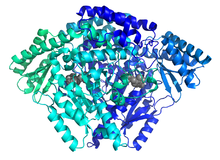Histidine decarboxylase
| Histidine Decarboxylase | |||||||||
|---|---|---|---|---|---|---|---|---|---|

Cartoon depiction of C-truncated HDC dimer with PLP residing in active site.
|
|||||||||
| Identifiers | |||||||||
| EC number | 4.1.1.22 | ||||||||
| CAS number | 9024-61-7 | ||||||||
| Databases | |||||||||
| IntEnz | IntEnz view | ||||||||
| BRENDA | BRENDA entry | ||||||||
| ExPASy | NiceZyme view | ||||||||
| KEGG | KEGG entry | ||||||||
| MetaCyc | metabolic pathway | ||||||||
| PRIAM | profile | ||||||||
| PDB structures | RCSB PDB PDBe PDBsum | ||||||||
| Gene Ontology | AmiGO / EGO | ||||||||
|
|||||||||
| Search | |
|---|---|
| PMC | articles |
| PubMed | articles |
| NCBI | proteins |
Histidine decarboxylase (HDC) is an enzyme responsible for catalyzing the decarboxylation of histidine to form histamine. In mammals, histamine is an important biogenic amine with regulatory roles in neurotransmission, gastric acid secretion and immune response. Histidine decarboxylase is the sole member of the histamine synthesis pathway, producing histamine in a one-step reaction. Histamine cannot be generated by any other known enzyme. HDC is therefore the primary source of histamine in most mammals and eukaryotes. The enzyme employs a pyridoxal 5'-phosphate cofactor, in similarity to many amino acid decarboxylases. Eukaryotes, as well as gram-negative bacteria share a common HDC, while gram-positive bacteria employ an evolutionarily unrelated pyruvoyl-dependent HDC. In humans, histidine decarboxylase is encoded by the HDC gene.
Histidine decarboxylase is a group II pyridoxal-dependent decarboxylase, along with aromatic-L-amino-acid decarboxylase, and tyrosine decarboxylase. HDC is expressed as a 74 kDa polypeptide which is not enzymatically functional. Only after post-translational processing does the enzyme become active. This processing consists of truncating much of the protein's C-terminal chain, reducing the peptide molecular weight to 54 kDa.
...
Wikipedia
